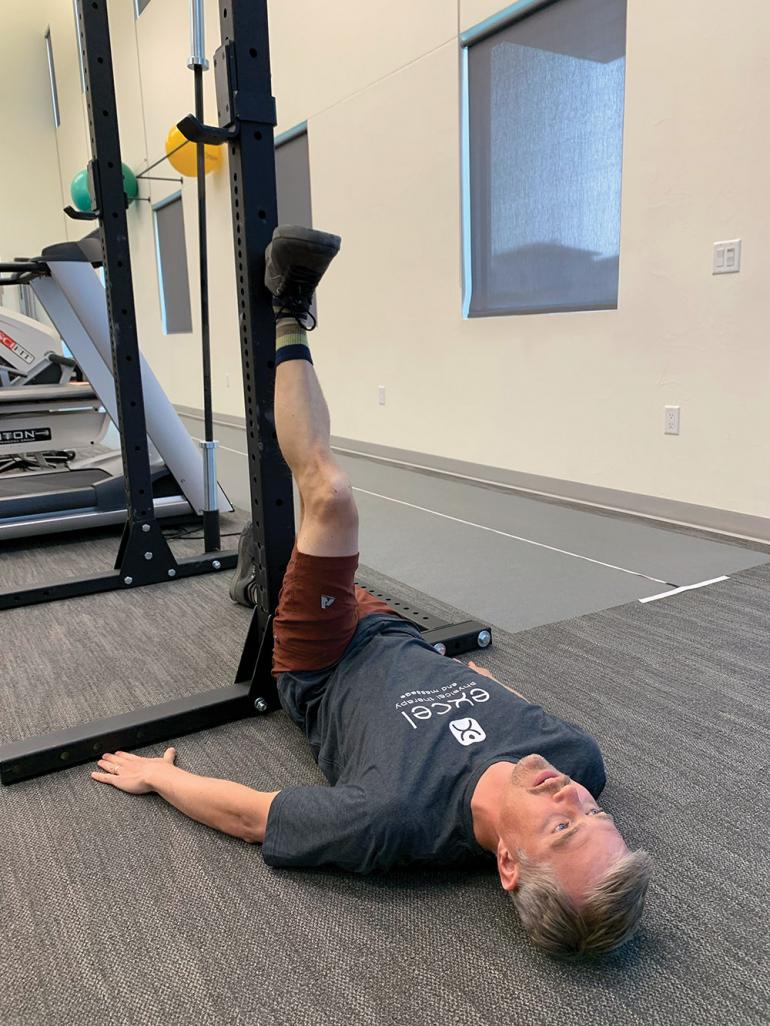Back in Action
How to stay on the singletrack this fall.
With the aspens turning golden, and dustings of snow in the alpine clearing the air, all-day epics on high-country singletrack are in order. After a whole summer of riding, let your skill, lungs, and legs be your limiting factor, not back pain. Back pain is twice as prevalent in biking than in other endurance sports. Thing is, it doesn’t have to be. To keep it at bay, all you need is to address your bike fit, strength, flexibility, and training.
Bike Fit
Position on the bike influences stress on your back. Three main factors to address are saddle position, saddle tilt, and bar drop.
Saddle Position. Moving your saddle forward or back changes the length of your bike’s cockpit. Too far forward and your cockpit will be cramped, causing your back to bend more than it should. Too far back and your cockpit will be stretched out. Aim to position the saddle so your spine is neutral without much effort.
Saddle Tilt. The tilt of your bike seat affects posture, and thus, stresses your spine. If your saddle is tilted nose up, your lower back locks out, increasing stress. Ideally, saddle tilt should be neutral or slightly nose down (1-2 degrees). Keep in mind that with full-suspension bikes, you’ll need to account for suspension sag, so tilt the seat slightly lower (3-4 degrees). Though, if the saddle is tilted too far down, it can cause excessive pressure on your hands as well as your perineum, resulting in pain and numbness.
Bar Drop. This is the distance between the height of your saddle and handle bars. The lower your bars, the more flexibility and strength required. Bars that are too low cause excessive stress on your back. Similar to saddle position, you want your bar drop at a height that allows for a neutral spine without much effort.
Strength, Flexibility & Training
To ride all day, your body must have the capacity. This requires training on the bike as well as off. There is no substitute for time in the saddle, but in order to avoid an overuse injury, you need to be strategic. Progress your volume and climbing gradually: a 10-20% increase per week.
Supplementing time on the bike with some strength training and mobility work is also important. These days, core strength gets all the attention, but back-extension strength is the most important for resolving and avoiding back pain on your bike. Build back-extensor strength with these exercises:
SB Extension. On your stomach, curl over a physio ball. Using your back extensors, raise your chest up until your back is flat. Hold to the point of a muscle burn (30-60 seconds). Repeat for a total of 5 minutes, twice per week.
Pendlay Rows. Hold a barbell close to your shins, standing with your feet shoulder-width apart. Tighten your abs and perform a hip hinge: push your butt back, and bend at the waist, lowering until you can grip the bar. Squeeze your glutes, making sure your hips are lower than your shoulders. Squeeze your shoulder blades. Maintaining this position, row the barbell to the bottom of your ribcage keeping your lower back down. Perform 3-4 sets of 6-10 repetitions, twice per week.
Lastly, mobility is crucial and should be built into your recovery sessions. Focus on hamstring and hip flexor mobility with these stretches, 1-2 sessions per day.
Couch Stretch. Place one foot behind you on a couch and kneel with the other leg in front of you. Then, bring your trunk upright until you feel a moderate stretch. Hold this for 3 sets of 1 minute or 1 set of 3 minutes. Repeat on other leg.
Doorway Stretch. Lie on your back with one leg on the floor, knee straight. Place the heel of your other leg up on the doorjamb. Scoot your body closer to the doorjamb until you feel a moderate stretch. Hold this stretch for 3 sets of 1 minute or 1 set of 3 minutes. Repeat on other leg.
Finally, work in a good yoga routine. Just 15 minutes of yoga after each ride will go a long way toward proper recovery. Bozeman has plenty of great instructors, so if you’re in doubt, hit one up to learn a good routine.
Ideally, you can avoid mountain-biking back pain with what I’ve just described. If not, visit a physical therapist to stay on the singletrack.
Dr. Jason Lunden, PT, SCS, is a board-certified specialist in sports physical therapy and a professional bike-fitter at Excel Physical Therapy. He is also a coach with the Bozeman NICA (National Interscholastic Cycling League) team. He enjoys helping others get back to the activities they love and helping get more folks on bikes.
















